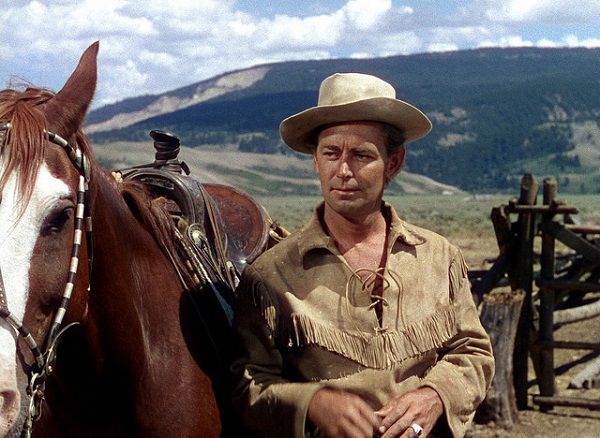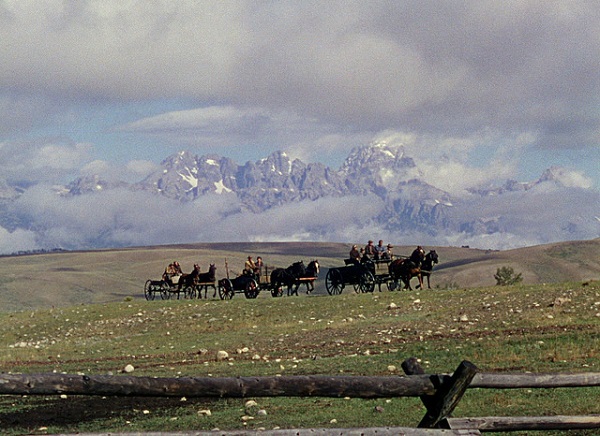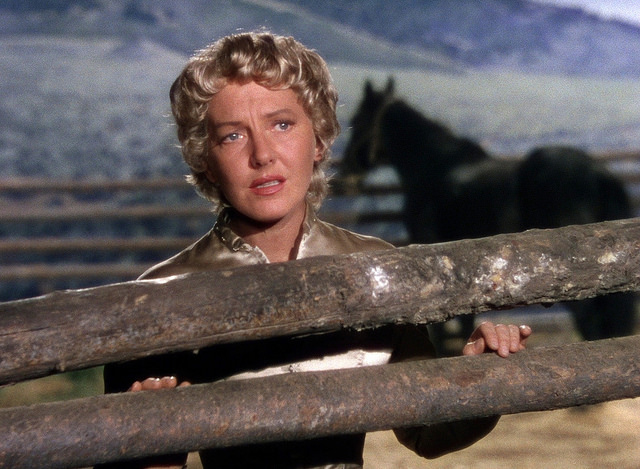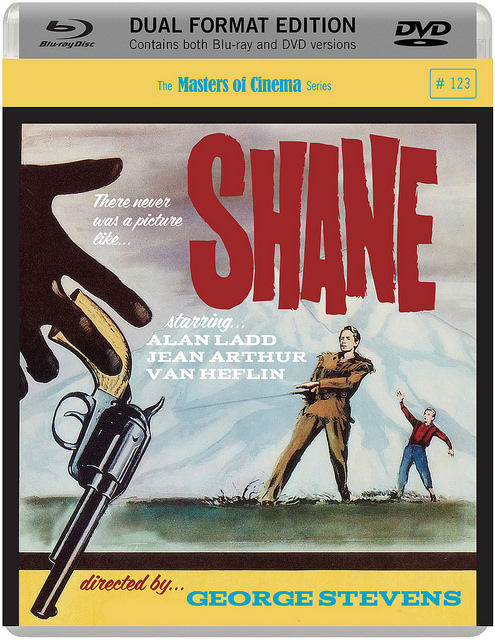Masters of Cinema Blu-ray Review: Shane
"A Classic, Grand Western"
Shane is often considered one of the best Westerns ever made, being nominated for six Academy Awards, winning the award for Best Cinematography and voted the third best Western by the AFI. It was also listed as the 45th best movie in AFI's 100 Years... 100 Movies list in 2007. Now it has been remastered and been made a part of the Masters of Cinema series.
Shane (Alan Ladd) is a lonesome traveller and gunslinger who befriends a farmer, Joe Starrett (Van Heflin), his wife Marian (Jean Arthur) and young son Joey (Brandon deWilde) in a picturesque valley in Wyoming. The Starretts, along with all the other farmers in the valley are being bullied, harassed and intimated by the local landowner and beef baron, Ryker (Emile Meyer). Joe attempts to lead the resistance against Ryker and his men and Shane stand by his side.
 Shane
Shane is regarded as a highly influential Western, being seen as a crossroads between Classical Westerns and Revisionist Westerns. Shane as a character was seen as a forerunner to Clint Eastwood's The Man With No Name, a mysterious man who rides into town and rights an injustice. Eastwood's
Pale Rider is considered to be a loose remake of
Shane. Woody Allen has declared it as one of his favorite movies. One of the big set-pieces in
Shane was very similar to a key sequence in Quentin Tarantino's
The Hateful Eight.
Shane was directed by George Stevens whose best works came in the 1950s. His goal was to elevate the Western and make it more a drama than an adventure. Action is toned down with the big scenes being a bar fight and two shootings. When guns are fired they are loud and impactful and if there are fights the participants get bloody. Stevens shows that this was a tough world, where the farmers have to graft, made even worse because of Ryker's sabotage. This is a settlement that is in early stages of development, so roads were nothing more than mud tracks and the town was basically a general store and a saloon and the law is days away.

The movie is set in a time where the West has been tamed and Ryker justified his actions by saying his generations were the ones who settled the land and deserve a reward for doing so - he debates with Starrett over the ethics and history of his claim.
Shane is not just a movie about a lone gunman, it's also a story about a community struggling against a cruel land owner, asserting their rights to live, work and worship anywhere they want, basic American values. Or if you prefer, the film is a more Marxist interpretation about the proletariat standing up against an oppressive government and business barons who are trying to take the farmers' land and livelihood. In the special features, Neil Sinyard said one review criticized
Shane for being a Western for people who do not like Westerns, which leads to the question of why is that bad? Surely, it's good that the filmmakers were trying to expand its audience.
Shane is a still a classical Western, it's not an early version of a Sergio Leone style movie.
Shane is a movie about the grand sweep of the landscape and it was deserving of its Oscar win. The cinematography of the Wyoming countryside is beautiful, yet a sparringly populated part of the world, a collection of wide green plains and small farms surrounded by the mountains. It is a wonderful example of Technicolor cinematography and the bright colors it produced. Other scenes were shot in studios, mostly the interiors, but the 4th July celebrations were obviously shot on a soundstage which was very distracting considering the quality of the rest of the movie.
 Shane
Shane is blessed with an excellent cast, particularly from Ladd as Shane the gunslinger who clearly came from a troubled past, being very jumpy and preparing to grab his gun when he hears a loud sound. He is a character trying to move on from his past, taking off his Native American style clothing in favor of farm clothes and not wearing his gun. There is a great subtlety with Ladd and Archer's performances, that they share an unspoken attraction, glancing at each other and doing small actions but are unable to act upon it. Most of the actors could say a lot with just a small look with the camera lingering on them. The acting was much more restrained than in other movies from this period.
A good portion of the movie is seen through Joey's eyes. He is the first character to meet Shane as he approaches the homestead and ends up idolizing the man, seeing him as a second father figure. He is the one who watches the fight in saloon and admires Shane for his willingness to stand his ground for what is right. deWilde was nominated for the Oscar for Best Supporting Actor, one of the younger actors to do so. He was fine at playing the wide innocent, but his performance does not hold up to the rest of the cast as his strains to voice emotion, comes off as fake. It is harsh to say, but deWilde did play an annoying child character.
Shane is a glorious looking movie because of its cinematography, locations, costumes and art-direction. It works as a drama and a Western thanks to most of the cast and the writing. It's a good old fashioned picture.
 Special Features:
Special Features: The 2-disc Blu-ray set comes with a commentary by George Stevens Jr. and associate producer Ivan Moffat and Lux Theater radio production which Alan and Van Heflin reprise their roles. The Blu-ray also comes with an anaylsis with Professor Neil Sinyard from the University of Hull talking about the career of George Stevens and the importance of the movie. The second disc comes with the movie in various formats.
A one disc various is set to come out in June.
Amazon.co.uk - 2-Disc version
Amazon.co.uk - 1-Disc version
Pros
- Subtle performances from most of the cast
- Beautiful cinematography
Cons
- deWilde's performance
- The second disc of extras
 Shane is regarded as a highly influential Western, being seen as a crossroads between Classical Westerns and Revisionist Westerns. Shane as a character was seen as a forerunner to Clint Eastwood's The Man With No Name, a mysterious man who rides into town and rights an injustice. Eastwood's Pale Rider is considered to be a loose remake of Shane. Woody Allen has declared it as one of his favorite movies. One of the big set-pieces in Shane was very similar to a key sequence in Quentin Tarantino's The Hateful Eight.
Shane was directed by George Stevens whose best works came in the 1950s. His goal was to elevate the Western and make it more a drama than an adventure. Action is toned down with the big scenes being a bar fight and two shootings. When guns are fired they are loud and impactful and if there are fights the participants get bloody. Stevens shows that this was a tough world, where the farmers have to graft, made even worse because of Ryker's sabotage. This is a settlement that is in early stages of development, so roads were nothing more than mud tracks and the town was basically a general store and a saloon and the law is days away.
Shane is regarded as a highly influential Western, being seen as a crossroads between Classical Westerns and Revisionist Westerns. Shane as a character was seen as a forerunner to Clint Eastwood's The Man With No Name, a mysterious man who rides into town and rights an injustice. Eastwood's Pale Rider is considered to be a loose remake of Shane. Woody Allen has declared it as one of his favorite movies. One of the big set-pieces in Shane was very similar to a key sequence in Quentin Tarantino's The Hateful Eight.
Shane was directed by George Stevens whose best works came in the 1950s. His goal was to elevate the Western and make it more a drama than an adventure. Action is toned down with the big scenes being a bar fight and two shootings. When guns are fired they are loud and impactful and if there are fights the participants get bloody. Stevens shows that this was a tough world, where the farmers have to graft, made even worse because of Ryker's sabotage. This is a settlement that is in early stages of development, so roads were nothing more than mud tracks and the town was basically a general store and a saloon and the law is days away.
 The movie is set in a time where the West has been tamed and Ryker justified his actions by saying his generations were the ones who settled the land and deserve a reward for doing so - he debates with Starrett over the ethics and history of his claim. Shane is not just a movie about a lone gunman, it's also a story about a community struggling against a cruel land owner, asserting their rights to live, work and worship anywhere they want, basic American values. Or if you prefer, the film is a more Marxist interpretation about the proletariat standing up against an oppressive government and business barons who are trying to take the farmers' land and livelihood. In the special features, Neil Sinyard said one review criticized Shane for being a Western for people who do not like Westerns, which leads to the question of why is that bad? Surely, it's good that the filmmakers were trying to expand its audience.
Shane is a still a classical Western, it's not an early version of a Sergio Leone style movie. Shane is a movie about the grand sweep of the landscape and it was deserving of its Oscar win. The cinematography of the Wyoming countryside is beautiful, yet a sparringly populated part of the world, a collection of wide green plains and small farms surrounded by the mountains. It is a wonderful example of Technicolor cinematography and the bright colors it produced. Other scenes were shot in studios, mostly the interiors, but the 4th July celebrations were obviously shot on a soundstage which was very distracting considering the quality of the rest of the movie.
The movie is set in a time where the West has been tamed and Ryker justified his actions by saying his generations were the ones who settled the land and deserve a reward for doing so - he debates with Starrett over the ethics and history of his claim. Shane is not just a movie about a lone gunman, it's also a story about a community struggling against a cruel land owner, asserting their rights to live, work and worship anywhere they want, basic American values. Or if you prefer, the film is a more Marxist interpretation about the proletariat standing up against an oppressive government and business barons who are trying to take the farmers' land and livelihood. In the special features, Neil Sinyard said one review criticized Shane for being a Western for people who do not like Westerns, which leads to the question of why is that bad? Surely, it's good that the filmmakers were trying to expand its audience.
Shane is a still a classical Western, it's not an early version of a Sergio Leone style movie. Shane is a movie about the grand sweep of the landscape and it was deserving of its Oscar win. The cinematography of the Wyoming countryside is beautiful, yet a sparringly populated part of the world, a collection of wide green plains and small farms surrounded by the mountains. It is a wonderful example of Technicolor cinematography and the bright colors it produced. Other scenes were shot in studios, mostly the interiors, but the 4th July celebrations were obviously shot on a soundstage which was very distracting considering the quality of the rest of the movie.
 Shane is blessed with an excellent cast, particularly from Ladd as Shane the gunslinger who clearly came from a troubled past, being very jumpy and preparing to grab his gun when he hears a loud sound. He is a character trying to move on from his past, taking off his Native American style clothing in favor of farm clothes and not wearing his gun. There is a great subtlety with Ladd and Archer's performances, that they share an unspoken attraction, glancing at each other and doing small actions but are unable to act upon it. Most of the actors could say a lot with just a small look with the camera lingering on them. The acting was much more restrained than in other movies from this period.
A good portion of the movie is seen through Joey's eyes. He is the first character to meet Shane as he approaches the homestead and ends up idolizing the man, seeing him as a second father figure. He is the one who watches the fight in saloon and admires Shane for his willingness to stand his ground for what is right. deWilde was nominated for the Oscar for Best Supporting Actor, one of the younger actors to do so. He was fine at playing the wide innocent, but his performance does not hold up to the rest of the cast as his strains to voice emotion, comes off as fake. It is harsh to say, but deWilde did play an annoying child character.
Shane is a glorious looking movie because of its cinematography, locations, costumes and art-direction. It works as a drama and a Western thanks to most of the cast and the writing. It's a good old fashioned picture.
Shane is blessed with an excellent cast, particularly from Ladd as Shane the gunslinger who clearly came from a troubled past, being very jumpy and preparing to grab his gun when he hears a loud sound. He is a character trying to move on from his past, taking off his Native American style clothing in favor of farm clothes and not wearing his gun. There is a great subtlety with Ladd and Archer's performances, that they share an unspoken attraction, glancing at each other and doing small actions but are unable to act upon it. Most of the actors could say a lot with just a small look with the camera lingering on them. The acting was much more restrained than in other movies from this period.
A good portion of the movie is seen through Joey's eyes. He is the first character to meet Shane as he approaches the homestead and ends up idolizing the man, seeing him as a second father figure. He is the one who watches the fight in saloon and admires Shane for his willingness to stand his ground for what is right. deWilde was nominated for the Oscar for Best Supporting Actor, one of the younger actors to do so. He was fine at playing the wide innocent, but his performance does not hold up to the rest of the cast as his strains to voice emotion, comes off as fake. It is harsh to say, but deWilde did play an annoying child character.
Shane is a glorious looking movie because of its cinematography, locations, costumes and art-direction. It works as a drama and a Western thanks to most of the cast and the writing. It's a good old fashioned picture.
 Special Features: The 2-disc Blu-ray set comes with a commentary by George Stevens Jr. and associate producer Ivan Moffat and Lux Theater radio production which Alan and Van Heflin reprise their roles. The Blu-ray also comes with an anaylsis with Professor Neil Sinyard from the University of Hull talking about the career of George Stevens and the importance of the movie. The second disc comes with the movie in various formats.
A one disc various is set to come out in June.
Amazon.co.uk - 2-Disc version
Amazon.co.uk - 1-Disc version
Special Features: The 2-disc Blu-ray set comes with a commentary by George Stevens Jr. and associate producer Ivan Moffat and Lux Theater radio production which Alan and Van Heflin reprise their roles. The Blu-ray also comes with an anaylsis with Professor Neil Sinyard from the University of Hull talking about the career of George Stevens and the importance of the movie. The second disc comes with the movie in various formats.
A one disc various is set to come out in June.
Amazon.co.uk - 2-Disc version
Amazon.co.uk - 1-Disc version